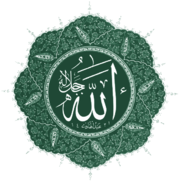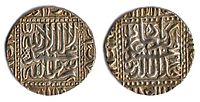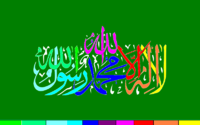- Shahada
-
This article is about the Islamic creed. For the Islamic history book, see No god but God. For other uses, see Shahada (disambiguation).
This article is part of the series: Islam 
 Silver coin of the Mughal Emperor Akbar with inscriptions of the Islamic declaration of faith, the declaration reads: "There is none worthy of worship but God, and Muhammad is the messenger of God."
Silver coin of the Mughal Emperor Akbar with inscriptions of the Islamic declaration of faith, the declaration reads: "There is none worthy of worship but God, and Muhammad is the messenger of God."
The Shahada (Arabic: الشهادة aš-šahādah
 audio (help·info)) (from the verb شهد šahida, "he witnessed"), means "to know and believe without suspicion, as if witnessed"/testification; it is the name of the Islamic creed. The shahada is the Muslim declaration of belief in the oneness of God (tawhid) and acceptance of Muhammad as God's prophet. The Sunni declaration reads:
audio (help·info)) (from the verb شهد šahida, "he witnessed"), means "to know and believe without suspicion, as if witnessed"/testification; it is the name of the Islamic creed. The shahada is the Muslim declaration of belief in the oneness of God (tawhid) and acceptance of Muhammad as God's prophet. The Sunni declaration reads:- لا إله إلا الله محمد رسول الله (lā ʾilāha ʾillallāh, Muḥammad rasūlu-llāh) (in Arabic)
- There is no god but God, and Muhammad is the messenger of God. (in English)
In the tradition of the Shia Muslims, there is the addition of "وعليٌ وليُّ الله", wa ʿAli-yyun wali-yyu-llāh ["and Ali is the wali (viceregent) of God"].[1]
The word Shahādah is a noun stemming from the verb shahida meaning to observe, witness, or testify; when used in legal terms, shahādah is a testimony to the occurrence of events such as debt, adultery, or divorce.[2] The shahādah can also be expressed in the dual form shahādatān (= "two testifyings"), which refers to dual act of observing or seeing and then the declaration of the observation. The two acts in Islam are observing or perceiving that there is no god but God and testifying or witnessing that Muhammad is the messenger of God. In a third meaning, shahādah can mean martyrdom, the shahid (martyr) demonstrating the ultimate expression of faith.[3]
A single honest recitation of the Shahadah in Arabic is all that is required for a person to become a Muslim. This declaration, or statement of faith, is called the Kalima, literally "word". Recitation of the Shahadah, the "oath" or "testimony", is the most important of the Five Pillars of Islam for Muslims. Non-Muslims wishing to convert to Islam do so by a public recitation of this creed.[4] Technically the Shi'a do not consider the Shahadah to be a separate pillar, but connect it to the Aqidah.[5] The complete Shahadah cannot be found in the Quran, but comes from hadiths.[6]
Contents
Recitation
- Arabic text: أشهد أن لا إله إلا الله و أشهد أن محمد رسول الله.
- Romanization: ʾašhadu ʾan lā ʾilāha ʾilla (A)llāh, wa ʾašhadu ʾanna Muḥammada(n) rasūlu (A)llāh
A single honest recitation of the Shahadah in Arabic is all that is required for a person to convert to Islam according to most traditional schools (madhab).
In usage the two occurrences of ašhadu ʾanna (or similar) = "I testify that" or "I bear witness that..." are very often omitted.
Shia recite the kalima as follows: "ʾAšhadu an lā ʾilāha ʾilla-llāha, wa ʾašhadu anna Muḥammad(an) ʿAbduhu wa rasūluhu wa ʾašhadu ʾanna mūlānā ʿAli-yyun wali-yyu-llāh.", and the oath now means: "I bear witness that there is no god but God, and I bear witness that Mohammad is God's servant and His Messenger and I bear witness that Ali is God's wali (representative)." The last phrase is optional to some Shia. They feel that Ali's walayat is self-evident and need not be declared.[citation needed]
History

 A mancus / gold dinar of the king Offa of Mercia, copied from the dinars of the Abbasid Caliphate (774); probably unintentionally, it still includes the Arabic text Muhammad is the Apostle of God.Qiblah of imam Mustansir in Fatemid masjid of Cairo showing Kalema-tut-shahadat with phrase Ali-un Wali-u(A)l-lah
A mancus / gold dinar of the king Offa of Mercia, copied from the dinars of the Abbasid Caliphate (774); probably unintentionally, it still includes the Arabic text Muhammad is the Apostle of God.Qiblah of imam Mustansir in Fatemid masjid of Cairo showing Kalema-tut-shahadat with phrase Ali-un Wali-u(A)l-lahAnother of the earliest surviving translations of the Shahadah into a foreign language is in Greek, from the reign of al-Walid I (86–96 AH, 705–715 CE): Ούκ Έστι[ν θεός εἰ μὴ ὁ θεὸς μόνος·] Μααμὲ[τ ἀπόστολος θεοῦ] (Ouk esti[n theos ei mē ho theos monos;] Maame[t apostolos theou]).[7] "There is no god except for the God alone; Muhammad is the Apostle of God."; i.e. "Allah", the Arabic word for "the God", is translated as "ὁ Θεός" and Muhammad is transliterated as "Μωάμεθ".
The photo above shows auxiliary Qiblah in one of pillars in the (Mosque of Ibn Tulun in Cairo built in the Fatimid Caliphate Imam’s era of Egypt having engraved in stone the name of the 18th Imam Mustansir (1035-1094 A.D.) and the complete Kalema in the same form as above. “Lā ʾilāh-a ʾilla-llah, Muḥammad-an rasūl-ullāh, ʿAli-yyun wali-u(A)l-lah (clearly visible).”,
The Kalema in its complete Shia form also exists at the gate Bab al-Futuh built by Fatimid minister Badr al-Jamali (952-975 A.D.) at northern wall of Fatemid Cairo.
Conditions
Muslims believe that the shahadah is without value unless it is earnest. Islamic scholars have therefore developed, based on the data of the Quran and hadith, essential criteria for an expression of the shahadah to be earnest. These criteria are generally divided into seven or eight or nine individual criteria; the varying numbers and orderings are not due to disagreements about what the criteria actually are, but rather different ways of dividing them.[8]
One such list of seven critical conditions of the shahadah, without which it is considered to be meaningless, are as follows:[citation needed].
- Al-`Ilm (العلم): Knowledge of the meaning of the Shahadah, its negation and affirmation.
- Al-Yaqeen (اليقين): Certainty – perfect knowledge of it that counteracts suspicion and doubt.
- Al-Ikhlaas (الإخلاص): Sincerity which negates shirk.
- Al-Sidq (الصدق): Truthfulness that permits neither falsehood nor hypocrisy.
- Al-Mahabbah (المحبة): Love of the Shahadah and its meaning, and being happy with it.
- Al-Inqiad (الانقياد): Submission to its rightful requirements, which are the duties that must be performed with sincerity to God (alone) seeking His pleasure.
- Al-Qubool (القبول): Acceptance that contradicts rejection.
The second part of the Shahada carries several conditions as well:
- To believe in the Prophet and in whatever he said and conveyed in his message as the seal of the prophets.
- To obey him in whatever he commanded.
- To stay away from or avoid whatever he commanded Muslims not to do.
- To follow or emulate him in our ʿibādah (عبادة; worship), ʾaḫlāq (أخلاق; manners), and way of life.
- To love him more than you love yourself, your family and anything else in this world.
- To understand, practice, and promote his sunnah (habits) in the best way possible, without creating any chaos, enmity or harm.
Flags
National flag
The flag of Saudi Arabia, displaying the Shahadah. The flag of Somaliland, featuring the Shahadah The flag of the Islamic Emirate of Afghanistan, featuring the Shahadah The flag of Saudi Arabia is the only flag of an internationally recognized sovereign state which displays the shahada. The design from the Saudi flag has been used in the flag of the unrecognized state of Somaliland (1996).
The 2004 draft draft constitution of Afghanistan proposes a flag with the shahada in white script centered on a red background.
An analysis of the calligraphy used in the flag of Saudi Arabia and derived designs is presented below:
It can be seen in the second flag that the name of Allah (الله) is written in a higher position. The name for Allah is written twice in each flag, but the first ʾalif (ا) is written after the second lām (ل) only once in the first instance of Allah in the second flag (pink), and only once in the second appearance in the flag of Saudi Arabia (green). This overwriting is also visible for the lam of rasul(u) (light blue), but only in the Saudi Arabia flag. The ligature lām + ʾalif (لا) is always written the same way in the Saudi Arabia flag, but calligraphy is changed in the case of the second لا (red) of the second flag at the left.
Jihadist flags
Further information: Black flag of jihadFlags reported as in use in jihadism have been frequently displaying the shahada, usually on a black background, since ca. 2000. The Taliban used a white flag with the shahada inscribed in black from 1997, until 2001 as the flag of their Islamic Emirate of Afghanistan.
Flags showing the shahadaa, often written on a green background, have also been displayed by supporters of Hamas in rallies during the 2000s.
Turkish national anthem
The Shahadah is referenced in the eighth stanza of the Turkish national anthem which can be translated as:
Shia and Sufi
Muslims believe reference to previous prophets as Messengers (rusul), and a few groups (notably certain Sufi mystics) amend the declaration to mention prior prophets whose names are found in the Qur'an.[citation needed]
Sometimes أشهد أن ʾašhadu ʾan = "I witness that" is prefixed to each half of the Shahadah.
Sometimes و wa = "and" is prefixed to the first word of the second half of the Shahada.
Shī‘a Muslims add "وعليٌ وليُّ الله", meaning "and Ali is the wali (vicegerent) of God" (wa-ʿAli-yyun wali-yyu llāh).
See also
- (Not to be confused with) shahid
- La ilaha ilallah
- Profession (religious)
- Takfir
- Takbir
- Basmala (or Bismillah)
- Kalima
- Six Kalimas
- List of Islamic terms in Arabic
- List of Christian terms in Arabic
References
- ^ "The Origin of the Sunni/Shia split in Islam". Islamfortoday.com. http://www.islamfortoday.com/shia.htm. Retrieved 2011-05-23.
- ^ The New Encyclopedia of Islam, Cyril Glasse, Alta Mira Press, 2001, p.416.
- ^ The Encyclopaedia of Islam, Volume IX, Klijkebrille, 1997, p.201.
- ^ Farah (1994), p.135
- ^ "If You Decide to Convert they put this their most important pilar". http://www.al-islam.org/reflectionsnewmuslim/8.htm. Retrieved 2007-07-09.
- ^ "Shahadah". Albalagh.net. http://www.albalagh.net/kids/understanding_deen/Shahadah.shtml. Retrieved 2011-05-23.
- ^ "A Bilingual Papyrus Of A Protocol - Egyptian National Library Inv. No. 61, 86-96 AH / 705-715 CE". Islamic-awareness.org. 2005-12-20. http://www.islamic-awareness.org/History/Islam/Papyri/enlp1.html. Retrieved 2011-05-23.
- ^ "9 Point Shahadah". Islamtomorrow.com. 2002-08-06. http://www.islamtomorrow.com/9points.htm. Retrieved 2011-05-23.
External links
Categories:- Arabic words and phrases
- Five Pillars of Islam
- National symbols of Afghanistan
- National symbols of Saudi Arabia
- Spiritual practice
- Monotheism
- Statements (religion)
Wikimedia Foundation. 2010.









